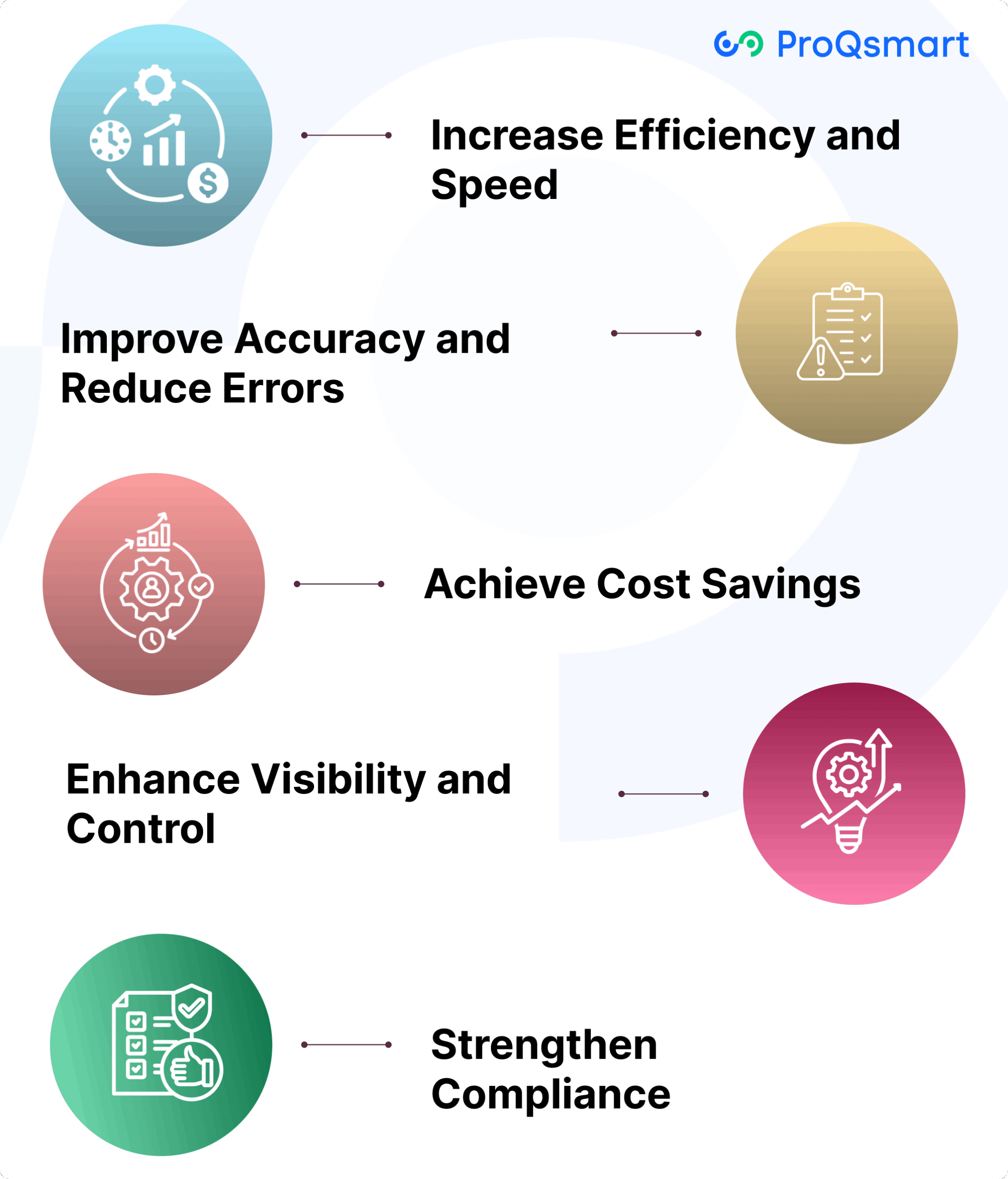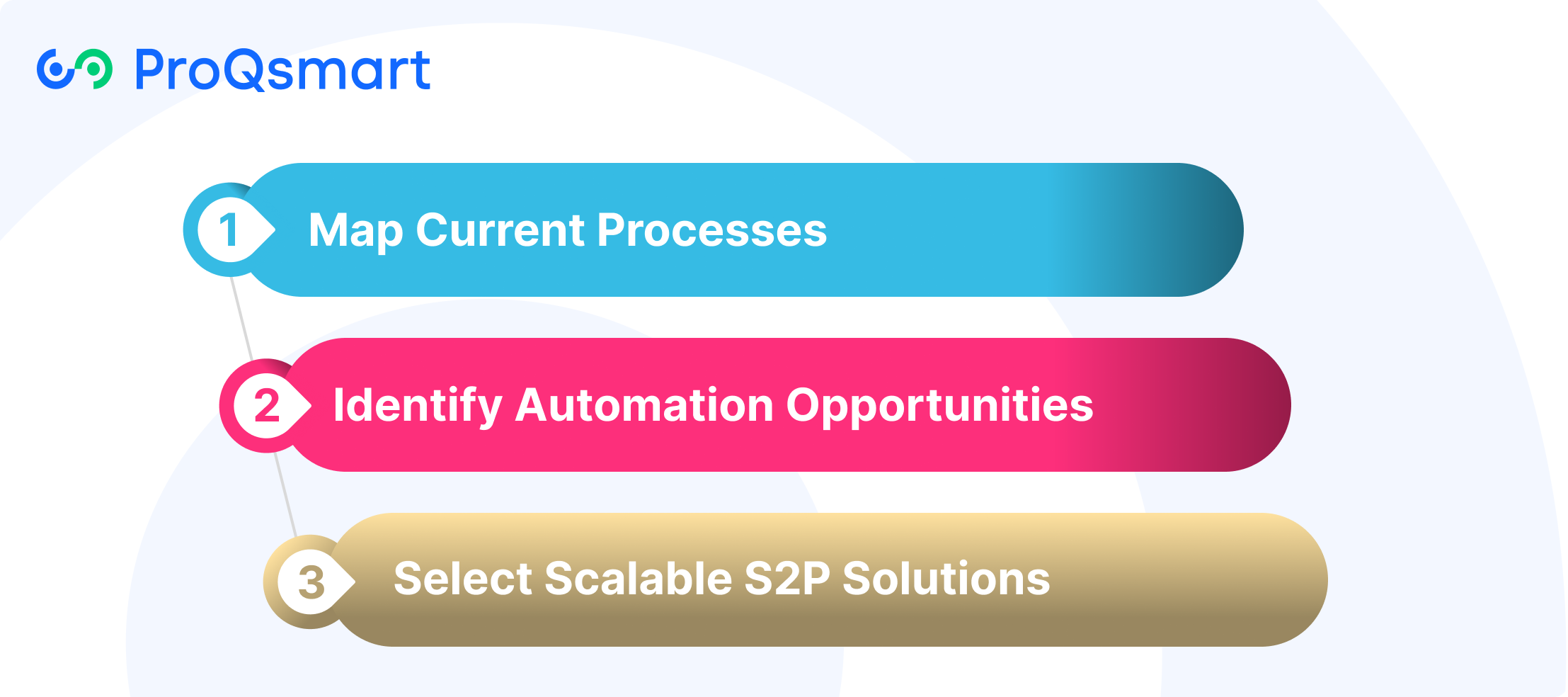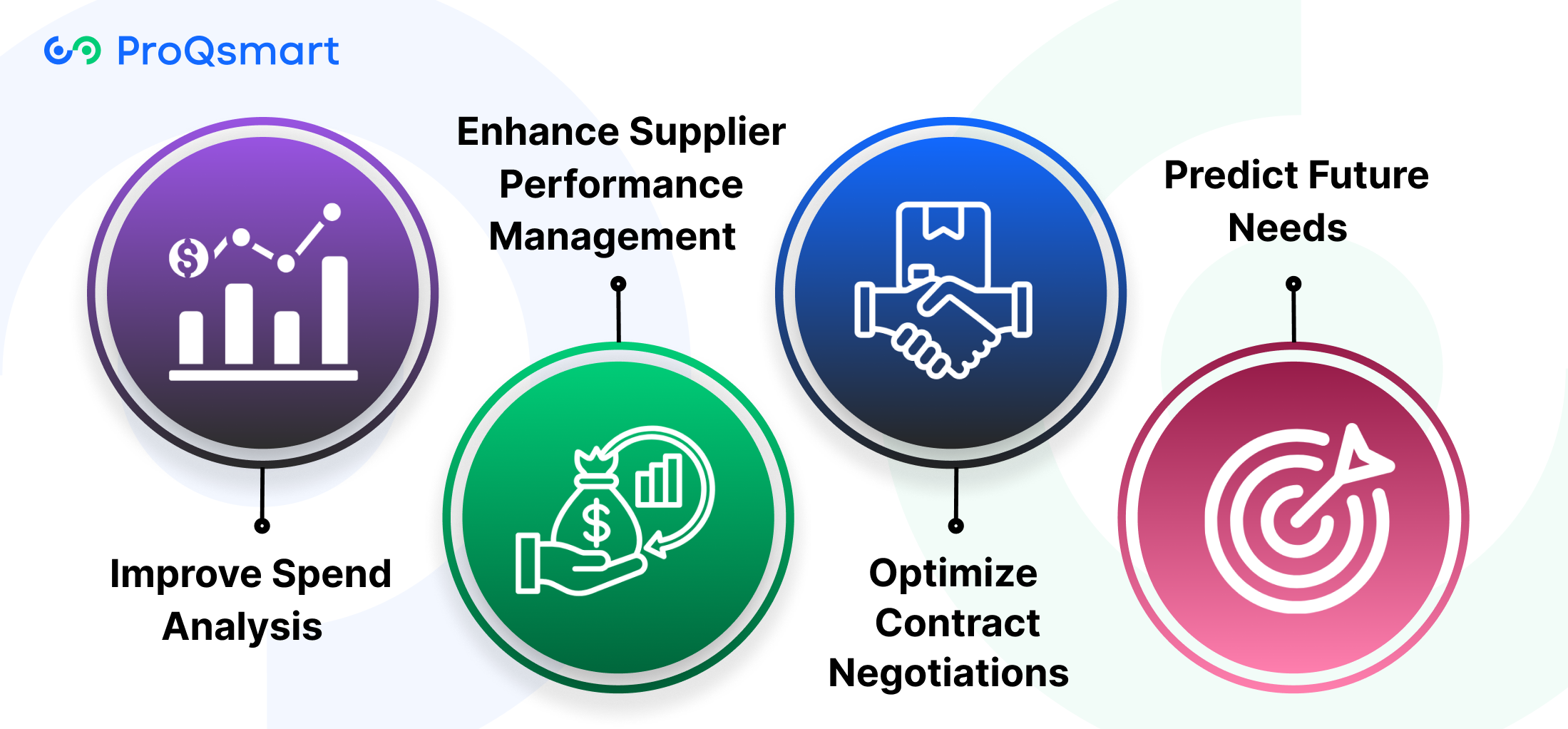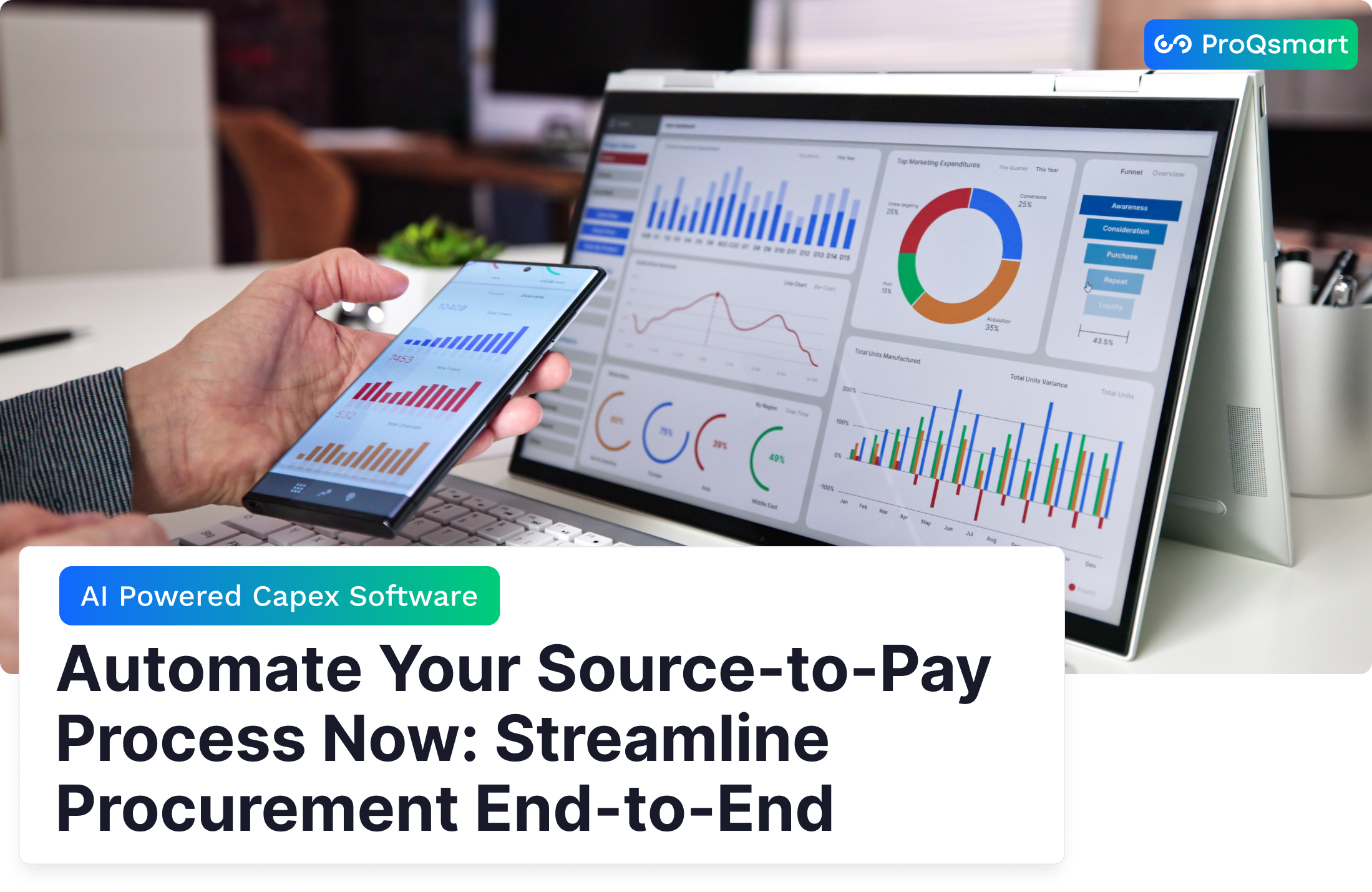The source-to-pay process oversees each phase of procurement. It begins with identifying and selecting suppliers, and it concludes with paying for the goods and services received.
The process starts with the recognition of a business requirement, followed by supplier solicitation, contract creation, and purchase order issuance. The cycle ends with the receipt of goods, acceptance verification, and payment.
By adopting these steps, source to pay creates seamless workflows, optimized vendor management, and significant cost savings. When organizations take this comprehensive approach, they have more transparency and control over their procurement activities.
This alignment allows them to accomplish their procurement and compliance goals much more efficiently. In the next sections, we’ll explore how source to pay can improve your procurement operations.
Understanding Source-to-Pay?
Source-to-Pay (S2P) is a workflow that unifies strategic sourcing and procurement. Along with the front-end modules, it brings together accounts payable and financial workflows, creating frictionless, full-cycle procurement.
First, the process starts with finding suppliers. Next, it ends with the payment, with goods or services received — connecting many of those steps along the way. Besides, by centralizing procurement data all in one place, S2P gives organizations more visibility and control, helping them make smarter decisions and quickly respond to shifts in the marketplace.
Moreover by automating processes, S2P encourages the collaboration between organizations and suppliers, facilitating better communication and offering tools to evaluate supplier performance. That not only makes for better supplier relationships, but powers efficient, productive procurement cycles.
To discover the powerful capabilities ProQsmart has to empower your business, they can also leverage contributory tools like supplier performance monitoring and real-time collaboration to strengthen partnerships and streamline operations.
Source-to-Pay Process Breakdown
The source-to-pay (S2P) process provides a unified, end-to-end framework that incorporates advanced S2P software for seamless integration of sourcing, contracting, ordering, receiving, invoicing, and payment processes. By utilizing this modern S2P platform, organizations can streamline their entire procurement process, enhancing operational procurement activities and improving procurement efficiency. This clarity allows businesses to develop impactful procurement strategies while leveraging the benefits of automation solutions and maximizing productivity.
With the integration of pay technology, the S2P process offers increased visibility and transparency, enabling data-driven decisions that optimize supply chain management. Besides, by breaking down the S2P process into distinct stages, organizations can better understand the components involved, ensuring effective procurement and fostering strong supplier relationships.
Sourcing and Procurement
Sourcing is an integral first step of the S2P process, wherein organizations identify and evaluate all qualified potential suppliers. Make no mistake, strategic sourcing decisions are extremely important to choose which suppliers can help your organization achieve key strategic goals beyond cost savings and quality.
Spend analysis is foundational in this step, as being able to analyze spending patterns enables procurement to make data-backed decisions that improve sourcing strategies and lead to optimized results. In addition to lowering procurement costs, good sourcing builds the entire procurement lifecycle by developing long-term, mutually beneficial supplier relationships.
Contract Management
Contract management helps ensure that your relationships with suppliers are well defined, with clear terms and conditions set forth. Clear, detailed provisions enable both compliance and accountability, helping to prevent risk-taking behavior.
Best practices include thorough negotiation to align terms with business objectives and regular monitoring of supplier performance against benchmarks. Thus, this phase protects procurement activity from risk and focuses vital operations on activities that support organizational priorities.
Purchasing and Requisition
The purchasing phase further embodies the procurement process. Purchase requisitions are used to formalize requests for goods or services, and purchase orders create legally binding agreements.
Errors like vague requisitions or slow approvals can also break workflows, making expeditious processes extremely important.
Invoice Processing and Payment
This final stage of the pay process includes comparing invoices to purchase orders and approval signatures to confirm legitimacy. Through automation software, organizations can also enhance procurement efficiency by processing payments faster, improving cash flow and supplier relations.
Benefits of S2P Automation

By automating the Source-to-Pay (S2P) process with advanced S2P software, enterprises gain a streamlined, cohesive, and transparent procurement environment that drives improved business performance. This modern S2P platform connects all modules of the procurement cycle, aligning workflows and enhancing collaboration capabilities, ultimately equipping teams to realize more value from strategic sourcing.
Increase Efficiency and Speed
Automation speeds up procurement work by reducing time-consuming and repetitive manual work. From e-tendering to payment, automated systems streamline workflows, cutting unnecessary delays and ensuring on-time execution.
As an example, ProQsmart’s AI-driven platform makes bidding easier, encourages collaboration and automates workflows—all so teams can spend more time on the most important tasks. Not just to drive efficiency through faster procurement cycles but to gain a competitive advantage in increasingly dynamic markets.
Improve Accuracy and Reduce Errors
For instance, automated S2P systems can help eliminate human errors such as data entry mistakes and invoice mismatches. Automated compliance checks help buyers and suppliers automatically adhere to procurement policies, creating more efficiencies and reducing unnecessary risks.
Overall on time, correct processing improves overall performance, including the ability to collaborate with suppliers, and being ready for audits. With auditable, accurate sourcing data that strengthens compliance, ProQsmart gives you peace of mind through every operation.
Achieve Cost Savings
Automation reveals new opportunities for cost-saving by optimizing labor, procurement and negotiations. Sourcing organizations that are internally integrating spend analysis accomplish 41% greater savings per sourcing project.
ProQsmart enables budget-driven, needs-based procurement and dynamic negotiations, maximizing ROI in tangible ways.
Enhance Visibility and Control
With use of near real-time analytics and embedded dashboards, automated S2P systems provide improved visibility to support better decision-making and proactive supplier management.
ProQsmart’s 360-degree visibility surfaces cost-cutting opportunities, while centralized data access fosters transparency and accountability.
Strengthen Compliance
Automated systems like ProQsmart enhance procurement efficiency, ensuring regulatory compliance and facilitating audits while fostering a strong, long-lasting procurement bedrock through effective supplier management.
Overcome S2P Implementation Challenges
While Source-to-Pay (S2P) implementation offers incredible potential for efficiency, collaboration and cost optimization, organizations can still run into huge challenges. Addressing these challenges head-on is key to realizing the promise of S2P automation.
Also, aligning a robust tactical strategy with above-mentioned stakeholder engagement helps make the transition easier while ensuring long-term positive outcomes.
Address Technology Adoption Barriers
Resistance to new technologies from team members is a common hurdle. Additionally, many professionals are used to working with legacy tools, which breeds reticence toward new technology.
Change management, both before and after S2P implementation, is key, leading to clear, thorough communication that highlights the benefits of S2P automation. Training programs and user support materials, including frequently asked questions and comprehensive user guides, help make this transition seamless.
Correspondingly creating a culture of innovation, in which staff are supported and empowered to explore the potential of digital tools, fosters sustained use over time. With tools such as workflow automation and AI-driven insights, ProQsmart simplifies the transition with an intuitive and effective approach.
Integrate Disparate Systems
Integrating multiple procurement platforms can be a complex process. Data silos and integration challenges are a big part of the problem.
Middleware solutions and interoperability strategies are crucial to ensure smooth data flow between systems. ProQsmart’s integration capabilities, including subcontractor management and real-time tracking, make these processes seamless.
Manage Upfront Investment Costs
While the leap year costs are a barrier to entry for most organizations, looking at the long-term ROI shows the payoff of S2P automation. Effective implementation will require smart budgeting that accounts for savings from cutting down on inefficiencies.
ProQsmart’s smart procurement solutions provide tangible cost savings, keeping your procurement department focused on your budget aspirations and facilitating savings initiatives.
Secure Data and Ensure Compliance
Compliance and data security are not optional. Automated systems improve security with clear and auditable sourcing information.
Routine usage audits and strict compliance with federal regulations mitigate dangers. By offering features such as supplier performance monitoring and transparent documentation, ProQsmart helps to ensure compliance.
Strategies for Successful S2P Automation

Automating the source-to-pay (S2P) process automates a range of activities, resulting in quantitative advantages such as more efficient workflows, improved compliance, and increased cost efficiencies. Building these outcomes takes a systematic, concerted effort focused on a cycle of ongoing improvement and tethering development closely to agency goals and priorities.
Below, we take a look at three major strategies that are crucial for success with S2P automation.
Map Current Processes
The foundation of successful automation begins with a clear picture of your current S2P processes. Start by:
-
Viewing every stage of the procurement life-cycle, from sourcing through to payment.
-
Documenting workflows to ensure transparency and consistency.
-
Engaging a thorough line up of stakeholders from procurement managers to finance teams, to ensure you’re capturing the widest range of perspectives possible.
-
Identifying manual errors, delays, or other inefficiencies that automation can address.
For example, if manual invoice approvals across departments take two weeks, mapping these steps can expose bottlenecks. This allows automated solutions to drastically decrease processing times.
Identify Automation Opportunities
Automation thrives on targeted application. Focus on:
-
Time-consuming tasks like invoice processing, spend analysis, and vendor qualification.
-
Identifying bottlenecks, such as in contract approvals or supplier onboarding.
-
Adopting new approaches like technology to empower eAuctions, monitor real-time expenditure tracking, and ensure ongoing compliance.
ProQsmart, for example, takes e-tenders and automates workflows to accelerate processes. This keeps everyone compliant and saves valuable time.
Select Scalable S2P Solutions
Select s2p software that can scale with your enterprise. Prioritize tools with advanced s2p technology.
-
AI capabilities for spend analysis and supplier performance monitoring.
-
User-friendly interfaces to boost team adoption.
-
Simple, real-time collaboration features to help align procurement efforts with broader organizational missions.
Data Analytics in Source-to-Pay

Data analytics serves as a cornerstone for enhancing the source-to-pay (S2P) process by centralizing procurement data, improving visibility, and enabling informed decision-making. With the introduction of digital technologies, enterprises have more abilities to transform quickly to market fluctuations at a high velocity and shorten their processes.
S2P automation reduces reporting cycles by up to 46%. It ensures high tender performance, contract compliance, and offers a true, holistic financial picture, delivering millions in cost avoidance.
Improve Spend Analysis
Accurate and comprehensive spend analysis is essential for exposing inefficiencies inside procurement. By breaking down expenditure into defined categories, organizations are able to target spend that need to be decreased and more effectively deploy spend.
Tools such as ProQsmart, make this easier than ever before with dashboards that allow for data flow in real-time and automated tracking of spend. Spend analysis informs sourcing strategies, allowing businesses to negotiate more favorable supplier terms and align procurement with financial goals.
Enhance Supplier Performance Management
Data analytics empowers teams to evaluate suppliers through KPIs such as delivery reliability, quality metrics, and cost performance. By utilizing platforms like ProQsmart, which supports ongoing supplier performance monitoring, businesses can strengthen relationships through data-driven insights.
Regular reviews based on analytics foster trust, continuous improvement, and mutual growth.
Optimize Contract Negotiations
When it comes to contract negotiations, the ability to analyze historical data is invaluable. Metrics like pricing trends, supplier benchmarks, and historical compliance data inform approaches for getting the best terms possible.
By combining bid management and cost tracking, ProQsmart makes this process simple, providing transparency and compliance with government regulations.
Predict Future Needs
With predictive analytics, organizations can enhance procurement efficiency by predicting future procurement needs, allowing for better inventory management and risk reduction. Considerations such as demand trends, lead times, and budget constraints inform these forecasts, ensuring that the entire procurement process aligns with the organization’s long-term objectives.
Best Practices for S2P Optimization
Here’s how to strategically and methodically optimize the Source-to-Pay process. This method should help connect procurement actions with your organization’s objectives, focus on regulatory guidelines, and capitalize on technology to increase productivity.
By focusing on collaboration, governance, supplier relationships, user experience, continuous improvement, and cloud-based solutions, businesses can unlock significant value across their procurement operations.
Foster Cross-Functional Collaboration
Effective collaboration between procurement and other departments fosters informed decision-making and ultimately maximizes value. For example, including finance teams as stakeholders in budget-driven procurement guarantees that spend is aligned with organizational priorities. Involving operations improves spend forecasting accuracy.
Best practices such as shared dashboards and cross-departmental meetings to reinforce communication and teamwork go a long way.
Benefits of collaboration include:
-
Enhanced cost management through unified spending visibility.
-
Improved supplier selection by integrating diverse expertise.
-
Faster issue resolution via streamlined communication.
Common objectives, such as meeting sustainability goals and maximizing cost savings, bring teams together. This collaboration creates a more informed and cohesive procurement strategy.
Establish Clear Governance
Governance frameworks help provide accountability and regulatory compliance in S2P. Clearly define roles and responsibilities within procurement teams to create clear workflows and avoid bottlenecks.
Include the following in governance structures:
-
Standardized policies for supplier screening and contract audits.
-
Automated workflows to generate purchase orders (POs) and facilitate payments.
Centralized governance makes sure that all activities stay on track with overarching procurement policies and regulatory compliance standards, drastically reducing risk.
Monitor Supplier Relationships
One of the easiest ways to leverage procurement for success is by building strong supplier relationships. Consistently score suppliers on performance metrics such as adherence to contract terms, delivery times, and product quality.
Regular proactive communication, like quarterly business reviews, builds deeper partnerships and creates demand for continued innovation.
Prioritize User Experience
Easy-to-navigate S2P environments, such as ProQsmart, bring intuitive design to procurement. Elements like customizable automation, e-tender management, and live tracking support user friendliness and operational improvement.
Soliciting end-user feedback will be critical to ongoing software refinement, helping to ensure the platform continues to evolve with your business’s needs.
Embrace Continuous Improvement
Creating a culture of innovation and continuous adaptability will go a long way toward ensuring S2P’s long-term success. Through routine evaluations, expenditure analyses, and in-house training, cost improvement areas are continually identified.
This approach can push savings between 24%–41% per project.
Cloud-Based S2P Platforms
Indeed, advancements in cloud technology have dramatically improved accessibility and scalability. With ProQsmart’s AI-driven solutions, procurement workflows can be automated.
Supplier relationships are strengthened, compliance is guaranteed, and collaboration and transparency are promoted.
Conclusion
Source-to-pay (S2P) offers a streamlined approach to enhancing procurement by integrating sourcing with payment, thereby harmonizing the entire process. Automation significantly reduces errors, accelerates workflows, and results in cost savings. Utilizing the right tools provides greater control and transparency, empowering organizations to make more informed, data-driven decisions. By adhering to established best practices, businesses can develop systems that effectively meet current needs while scaling to accommodate future demands.
Intelligent data production is a key driver of successful outcomes, with robust analytics playing a crucial role in optimizing operations and identifying new opportunities for improvement. Focusing on best practices ensures sustained efficiency and continued progress toward organizational goals. Building a source-to-pay system today enables smarter decision-making, minimizes costs, and maximizes success across the entire procurement lifecycle.
To discover how ProQsmart can help optimize procurement processes, explore ProQsmart’s procurement solutions and book a personalized demo today.




